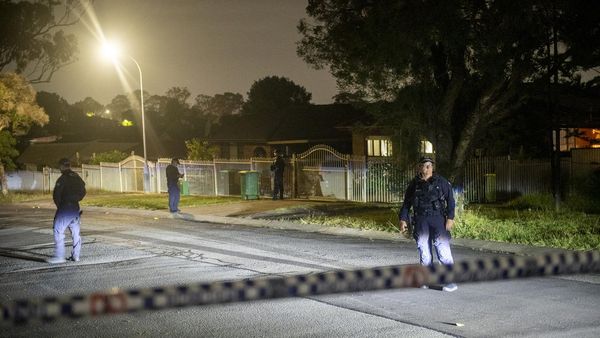
In the 100 days since Donald Trump returned to power, the new administration has driven tens of thousands of federal workers from a civil service it has denigrated as “bloated” and “corrupt”. Among its first targets: probationary workers like Cindi Hron.
Hron, a landscape architect with the US Forest Service, was one of thousands abruptly fired across the agency on 14 February, in an action some now refer to as the Valentine’s Day massacre, executed by Elon Musk’s newly empowered “department of government efficiency”, or Doge.
“As much as I could see it coming, it was still a gut punch,” she said. Hron was given just two hours to return her equipment before losing access to her government email.
In the weeks that followed, similar scenes played out across the government – nurses at the Department of Veterans Affairs, food safety regulators at the Department of Agriculture, scientists at the Department of Health and Human Services. Employees, along with unions and legal groups, challenged the legality of the widespread terminations. At least 24,000 of those dismissals led to court-ordered reinstatements, which have since been paused.
Whiplashing court orders have left probationary workers in a fragile state of limbo. Some have been rehired, while others remain on administrative leave. Some have received backpay and benefits, while others have not. Some were returned to work, put on administrative leave and then fired again, after an intervention by the supreme court.
“There is a state of confusion as to anybody’s status,” said Jeffrey Grant, a former deputy director at the Centers for Medicare and Medicaid Services.
Hron had already moved back to Pennsylvania, from where she had relocated to accept the Forest Service job in Utah, when she learned that she would be reinstated, in compliance with a ruling by the Merit Systems Protection Board, an independent agency responsible for protecting federal employees. The reversal was welcome but the return to work felt precarious. When her department extended a second “deferred resignation” offer, she decided to take it.
“Doge has just taken a baseball bat and it’s just breaking things,” she said. “It’s certainly not the way I ever anticipated leaving a job.”
***
Probationary workers are employees who generally have less than a year in their role after being hired or promoted, though they are often highly skilled and have years of prior experience in the federal government. While they lack the full job protections of longer-tenured civil servants during this period, probationary workers can only be removed for poor performance or conduct.
In late April, a federal judge in California said the administration’s suggestion that tens of thousands of probationary workers were dismissed because of their performance was “a total sham” and order several agencies to provide a retraction in writing.
But in a blow to efforts to challenge their removals, the office of special counsel, an independent watchdog agency, announced it was dropping its inquiry into a torrent of complaints that the Trump administration had unlawfully terminated probationary workers. The decision was a reversal of the conclusion reached by the previous head of the agency, Hampton Dellinger, who was fired by Trump.
Craig Becker, senior counsel for the AFL-CIO, which is challenging the administration’s firings of probationary employees, said a legal defense network established to provide assistance to federal workers has fielded many calls from employees struggling with questions over benefits and job status.
“It’s been a hellish way of treating people,” said Tom Di Liberto, a public affairs specialist and climate scientist at the National Oceanic and Atmospheric Administration (Noaa) who was among the probationary employees dismissed in February, rehired and put on administrative leave in March and dismissed again on 10 April.
Di Liberto’s probationary period would have ended before he was refired on 10 April, but the termination was backdated to 27 February.
“They didn’t want us basically to be able to say that we had employment,” he said. “I’m sure that’s not legal, but I’m sure that’s what the courts will decide.”
***
It is not clear how many federal employees were in a probationary status when Doge began its mass firings earlier this year. An analysis by the Partnership for Public Service estimates the number was roughly 250,000. At the time Trump won the election in November, the federal workforce employed just over 3 million people, excluding the roughly 1.3 million active-duty military personnel.
Musk initially promised Doge would slash $1tn – a sum so large he and Trump suggested some of the savings could be distributed to taxpayers. This month, Musk revised his target to $150bn – just 2% of the federal budget. A tracker of the savings Doge claims to have achieved is riddled with well-documented errors, duplications and inaccuracies.
The Doge team’s efforts have also cost billions of dollars. The Partnership for Public Service estimated Doge’s firings, rehirings, lost productivity and paid leave will cost upwards of $135bn this fiscal year, not including costs associated with court battles their actions have incited.
Americans broadly support Doge’s stated mission – tackling waste and inefficiency in government. And experts on the federal bureaucracy as well as workers themselves acknowledge that reforms are needed.
But the stories of fired workers, shared at town halls and protests, have helped rally raucous – and even poignant – opposition to Musk’s government-slashing initiative. Polls show Musk and Doge are increasingly unpopular. According to a recent Washington Post/ABC News/Ipsos poll, 56% of respondents agreed that Trump was “going too far” in laying off government employees.
“Efficiency is a cloak for a Project 2025 operation to gut the federal workforce and replace career civil servants with Trump loyalists,” said Rob Shriver, the former director of the office of personnel management, referring to the far-right blueprint for overhauling the federal government.
Shriver, who now serves as managing director of the Civil Service Strong initiative at Democracy Forward, a legal group contesting the administration’s sweeping dismissals of government employees, expressed concern that Doge’s brute-force approach to government cost-cutting could have lasting repercussions on the civil service.
The administration’s treatment of federal workers risked eroding longstanding expectations of job security and confidence in its public service mission – advantages that help the government recruit new talent.
“I think that the stability has been completely undermined by these antics,” Shriver said. “And I think folks have a lot of questions about what they would be asked to do were they to come in and work for a federal agency – whether what they would be asked to do would be in line with their values as somebody who wants to serve the public and takes an oath to the constitution.”
Even after Musk said recently he would step back from leading Doge, the administration has made clear its government-shrinking crusade is far from complete. And probationary workers say they feel more vulnerable than ever. Last week, Trump signed an executive order making it easier to fire probationary employees by expanding agency discretion over whether they attain full status.
Doge did not reply to multiple requests for comment.
“President Trump is the chief executive of the executive branch and reserves the right to fire anyone he wants,” the White House press secretary, Karoline Leavitt, said in a statement.
***
The day-to-day stress brought about by the administration’s demonization of federal workers as “deep state” bureaucrats working to thwart the president’s agenda has left the workforce deeply demoralized.
One reinstated probationary employee with the US Forest Service in Alaska, who spoke on condition of anonymity for fear of professional reprisal, said some days she feels so “downtrodden” that she can’t stop crying. At the same time she feels a deep sense of resolve to “hold the line” and “not comply in advance”.
“We are the indicator species in this situation,” she said. “This is happening to us first, but the ripple effects of not having us – and not having all of those protections that the federal government provides for the resources that people care so much about, and the lands that they subsist on – will be absolutely enormous.”
The anxiety and fatigue is by design. A destabilized civil service was central to the vision laid out by Russell Vought, head of the office of management and budget and chief architect of Project 2025, who once said: “We want the bureaucrats to be traumatically affected.”
Multiple probationary employees told the Guardian they expect to be targeted in future rounds of layoffs. Several said they were pursuing other opportunities or had accepted their agency’s buyout offer, while some remained hopeful they would prevail in court.
The mass exodus of probationary workers has already disrupted government functions and services – and is raising alarms about the loss of scientific and technical expertise.
“The US has been a leader in hurricane science and in weather forecasting,” said Andy Hazelton, a physical scientist who worked on hurricane modeling at Noaa. “We have so much talent, so much knowledge and data. But everything that’s happened, it’s kind of threatening that.”
Hazelton, who was among the probationary employees caught in the chaotic cycle of being fired, reinstated and dismissed again, said Noaa staff were already stretched thin. Staff reductions, coupled with proposed budget cuts, could affect work on the agency’s lifesaving forecasts just as hurricane season approaches, he warned.
“I worry that the forecasts, perhaps the improvements we’ve come to rely on, may not be as reliable going forward,” he said.
***
As Hron prepares to leave the Forest Service, she has been thinking about the oath she took nearly one year ago.
During a security training as part of her onboarding, Hron remembers incorrectly answering a question about the type of threat facing the agency. She assumed the answer was “foreign”, but the correct response was “domestic”. At the time, she found it surprising.
Now she has come to believe that the Trump administration’s war on federal workers is the very kind of domestic threat the agency warned of: “We just departed from the ethics, the guidelines and policies that shape what I understood the Forest Service to be.”







